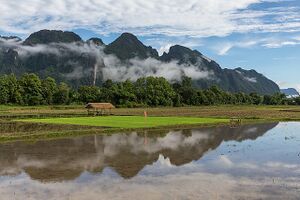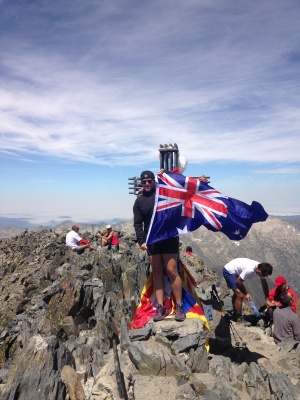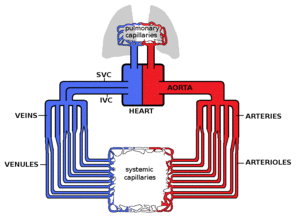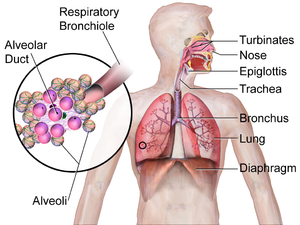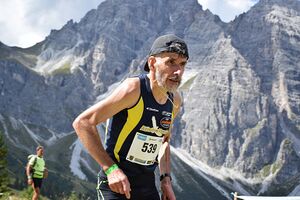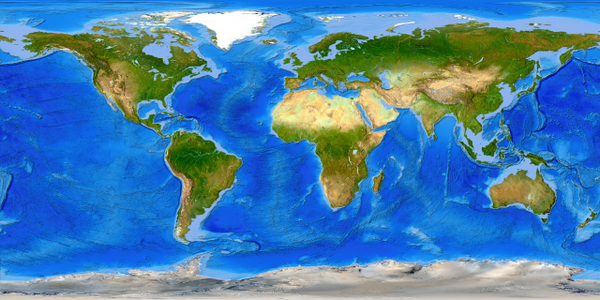Acclimatisation
Original Editor - Kapil Narale
Top Contributors - Kim Jackson
Introduction[edit | edit source]
A change in altitude from sea level may have an impact on an athlete's performance. A great impact may be noticed if an athlete trains at a certain altitude and competes at a different altitude. This may also affect individuals who move their habitat from one altitude to another, as they perform their exercises and activities. [1]
Environmental conditions at higher altitudes include: [1]
- Decreased atmospheric pressure (PO2)
- Lower air temperature and humidity
Atmospheric Pressure[edit | edit source]
It is noted that the atmospheric pressure is the greatest at sea level. As an individual ascends in altitude, the atmospheric pressure gradually decreases. This is because the air is less dense, and there is a lower concentration of gas molecules. [1]
The percentages of O2, N2, and CO2 are the same at sea level and at altitude, and would only change with changes in atmospheric or barometric pressure. With a higher altitude, there is a decrease in the partial pressure of oxygen (PO2). This has an effect on the saturation of oxygen to hemoglobin, and thus effects oxygen transport. [1]
Elevations of Altitude[edit | edit source]
These are the different categorizations of altitude levels: [2]
0m–500m is considered ‘Near sea level’.
~500m–2000m is considered ‘Low altitude’ - at this range of altitude, minor impairments of aerobic performance are noticeable.
>2000m–3000m is considered ‘Moderate altitude’ - at this range, mountain sickness can start to occur, and acclimatisation would be crucial for athletic performance.
>3000m–5500m is considered ‘High altitude’ - at this range, mountain sickness would become more severe, and acclimatisation would be more important, otherwise one's performance will be significantly inhibited.
>5500m is considered ‘Extreme altitude’ - at this range, increased exposure durations and periods would leads to gradual clinical deterioration. Care and preparation must be taken at these levels.
Acclimatisation to High Altitudes[edit | edit source]
It is a matter of fact that our bodies can acclimatise to high altitudes, especially if one is born or lives at such an altitude. Someone who immigrates or takes a trip to such an altitude will have drastic physiological and circulatory adaptations as they acclimatise to these new heights. [1] It is seen that at altitudes within 1000m, untrained individuals with normal respiratory functioning are able to maintain oxygen delivery and aerobic performance similar to their ability at sea level. [3]
This acclimatisation process includes an increase in red blood cell count. However, the acclimatisation of individuals who make a trip to locations at such an altitude will not be as complete as residents of those locations. This includes adults or children who grew up or lived at altitude in the long term. Those individuals who have had developing years at altitude will be more acclimatised to such an elevation compared to those who moved to altitude as adults and spent about one to four years in the elevated environment. [1]
There is a type of gene that can help in this situation. An increase in a gene, called Hypoxia Induced Factor-1 (HIF -1), is triggered by a low PO2 at altitude. HIF-1 activates genes concerning erythropoietin (EPO) production, which are involved in red blood cell production.
Erythropoietin are vascular growth factors which are involved in:
- New blood vessel production.
- Nitric oxide synthase which promotes the synthesis of nitric oxide, helping with vasodilation. [1][3]
With a exposure to altitude of a greater duration, erythropoietin levels peak after about 24-48 hours. They then decline to regular sea level values after about 14-28 days. [3]
The acclimatisation response to high altitude and low PO2 is to produce an increase in red blood cells, which can help supplement for the desaturation of hemoglobin. With the higher altitude, and the increased red blood cells, there is an increased concentration of hemoglobin. It should be noted that the concentration of hemoglobin at sea level is 156g/L. [1]
It was noticed that populations in different regions acclimatise to their elevated environments with slightly different methods. Peruvian permanent-altitude (>4500 metres) residents were believed to have acclimatised to their environment through a significantly increased hemoglobin concentration.
Individuals at high altitude in Tibet have acclimatised via a different method than those in the Andes, South America. Residents in Tibet adapt by increasing the oxygen saturation of hemoglobin, rather than increasing the concentration of hemoglobin which is done by the Andes'. However, the hemoglobin concentration may be 30g/L lower than the Andeans at similar altitudes.
The exceptional performance of the Tibetans at these altitudes has many physiological benefits, which include, an increased:
- VO2 max at altitude,
- Lung function,
- Capillary density,
- Forearm blood flow,
- Maximal cardiac output, and
- Level of oxygen saturation of hemoglobin. [1]
These different types of adaptations aren't merely chosen, but exist through evolution or genetics, which promotes an increase in red blood cell production (such as in the Andes) or an increase in oxygen saturation (such as with Tibetans), due to an increase in nitric oxide in the lungs, and thus an increase in blood flow. [1]
Effect on the Circulatory System[edit | edit source]
It should be known that VO2max is the product of maximal cardiac output (Q) and the maximal arteriovenous oxygen difference (a-vO2) - VO2 = Q x (a-vO2). The decrease in VO2max at altitude could be due to the decrease in one or both of these factors. [1]
As we know, oxygen extraction is a big contributor to decreased VO2 at all altitudes, with a decreased cardiac output having a greater effect at higher altitudes. [1]
We will establish that maximal cardiac output (Q) is the product of maximal heart rate (HR) and maximal stroke volume (SV) - Q = HR x SV. [1]
In various studies, it was found that heart rate was unchanged at altitudes up to 4000m, and changes in stroke volume were inconsistent. In that case, if the factors of cardiac output have no effect or a very minimal effect, it is likely that the arteriovenous oxygen difference (a-vO2) is the limiting factor. The main cause is the desaturation of arterial blood, from the lower partial pressure of oxygen at altitude. The lower atmospheric PO2 results in a lower alveolar PO2. The pressure gradient for oxygen diffusion between the alveoli and the pulmonary capillaries is reduced, and therefore the arterial PO2 is reduced. With the reduced arterial PO2 , there would be a decreased amount of oxygen bound to the hemoglobin. [1]
At sea level, oxygen saturation is about 96%-98%. This explains the normal SpO2 values of 95%-100%. On the other hand, at an altitude of 2300 metres, the oxygen saturation drops to about 88%, and at an altitude of 4000 metres, oxygen saturation falls to about 71%. [1]
Because of the desaturation of oxygen at altitude, the ability to transport oxygen to the active muscles is reduced, despite maximal cardiac output being unchanged with short exposure of altitude up to 4000m. At an elevation greater than 4300m, it is likely to see a lower maximal heart rate. It was found that maximal heart rate was 24-33 beats/minute lower at 4650 meters (15 300 ft) and 47 beats/minute lower at 6100 metres (20 000 ft). [1]
Contrary to a variable change in stroke volume with short exposures to altitude, a longer duration exposure results in a reduction of plasma volume, and thus a lower end diastolic volume and stroke volume. [1]
Therefore, with the effects of desaturation of hemoglobin, and the decrease in maximal cardiac output, VO2max decreases at a higher rate at higher altitudes. [1]
With the desaturation and decreased oxygen content per liter of blood, an increased cardiac output is needed. Despite there being a decreased maximal heart rate, the increased blood demand per minute results in an increased heart rate, especially since stroke volume changes are limited. [1]
Although there is a decreased content of oxygen at altitude, the demand of oxygen is the same, and the blood pressure is also comparable to that at sea level. There doesn't seem to be decreased contractility during maximal exercise at higher altitude. In this case, any cardiovascular risks that may occur at moderate altitude may be similar to those at sea level. [1]
Here is a video that describes the effect of altitude training on the heart of elite athletes:
Effect on the Respiratory System[edit | edit source]
As an individual ascends in altitude, and experiences a lower saturation of hemoglobin, they would experience hypoxia. Hypoxia is a condition of having lower than normal partial pressure of O2 (PO2) in the hemoglobin. [1]
As mentioned, air is less dense at altitude, and there are fewer molecules of oxygen. If someone wanted to ventilate the same amount of air/oxygen, then their ventilation rate would have to increase. [1]
At an elevation of 5600 metres (18 400 ft), the atmospheric pressure is one-half of that at sea level, and the number of oxygen molecules per liter of air is also one-half. Therefore, to take in the same amount of oxygen, their breathing rate would have to double. A large consequence of this, at higher altitudes (exceeding 4000m), would be the amount that the respiratory muscles, especially the diaphragm, have to work to reach VO2 values of 100-200x greater. This may induce fatigue on the diaphragm. [1]
Here is an in-depth video explaining the respiratory response to high altitude:
Athletes and the Effects of Acclimatisation[edit | edit source]
Most athletic events are held at altitudes with a minimal to no health risk to the athletes. However, the slightest increase in altitude can pose a threat to performance. [2]
At altitude, the decrease in air density and partial pressure of oxygen, in fact, have opposing effects on endurance, strength and power, and skills crucial for elite-level performance. The reduction in partial pressure of oxygen inhibits maximum aerobic capacity and endurance output, while the reduced air resistance, from the reduced air density, has minimal effect. However, these factors can outweigh each other with different types of activity (faster versus slower bouts such as sprinting or distance running, respectively). Strength and power would not be effected by altitude, though quick movement activities (sprint or relay) would be affected. Projectile motion activities, such as throwing or ski jumping, would be affected by the reduced air density. [2]
When considering short distance anaerobic Olympic events, such as track and field events, it can be noted that events at elevation (in Mexico City at ~2300m) may be performed quicker than events at sea level (Tokyo City). The low PO2 at altitude, thus the transport of oxygen to muscles, may not be a limiting factor. One main reason for this was concluded to be the lower air density providing less resistance for fast movements. [1]
With longer distances and times, greater than 2 minutes, it is evident that runners will have a challenge, due to the increased oxygen demand and reduced partial pressure of oxygen at altitude. [1]
This decrease in maximal aerobic power and performance of long distance runners, at altitude, is similar to the effects on performance with detraining. [1] Distance runners show a varying hematological response, reduced VO2max, and worsening of exercise performance with a short bout of activity at altitude. Similar effects can occur with a longer exposure. [3]
Thus, the effect of altitude definitely would be sport specific. [2]
For athletes to reduce their clinical risk and optimise performance at low to moderate altitude, it would be recommended to arrive at the site roughly 2 weeks before an event. Not only should they arrive 2 weeks prior to the event, they should rest 1-2 days before commencing or continuing with any training. Partial acclimatisation, which will lead to improved performance, can be gained within 5-7 days, but most athletes will acclimatise to moderate altitudes within 2 weeks. [2]
Hypoxic Training[edit | edit source]
When considering acclimatisation to altitude, an idea could be hypoxic training. However, there are some placebo-controlled double-blind studies which show that passive exposure to hypoxia over a duration of several hours does not improve aerobic or anaerobic performance. [2]
Live High and Train Low[edit | edit source]
A popular phenomenon to improve endurance performance is to 'live high and train low'. The 'live high' concept translates to an exposure of a low PO2. The 'train low' concept translates to doing exercise/workouts at sea level, thus to not effect the intensity or duration of the workout.
Some athletes are shown to have an improved performance with this kind of training, though many factors play a role, such as: [1]
- Types of athletes,
- Intensity and volume of training,
- Elevation of altitude, and
- Length of stay at altitude.
With this kind of training, athletes who initially have a relatively low VO2max have a greater potential of improving their VO2max compared to those athletes who already have a high VO2max. The individuals who improve the most were seen to have the lowest levels of initial hemoglobin mass. This is explained by the linear relationship between the increase in hemoglobin mass and VO2max after the 'Live High Train Low' training. This is also explained by the inverse relationship between the initial level of hemoglobin mass and the increase in hemoglobin mass, which occurs from the Live High Train Low training. [1]
Acclimatisation and Sweat Response[edit | edit source]
Sweat is generally stimulated as a response to an increase in core body temperature, though skin temperature can alter the threshold for sweating to begin. Although sweating happens with an increase in core body temperature, it is common to occur within a few seconds of starting exercise regardless of an increase core or skin temperature. However, sweating generally occurs with the activation of sweat glands. Inhibition of nitric oxide release from the skin decreases the sweat response. [3]
Risks[edit | edit source]
Acute Mountain Sickness[edit | edit source]
Non-acclimatised individuals with quick or short term exposure to moderate altitude may experience something called Acute Mountain Sickness (AMS). This is a self-limiting condition similar to a hang-over or a migraine attack. This condition can be treated with rest, and can be prevented with slow, staged, gradual ascent, or hypoxic exposure training (pre-acclimatisation). Severe obesity or pulmonary conditions are risk factors for AMS, and thus should be a precaution for any staff or personnel accompanying the athletes at moderate altitude. [2]
Living or sleeping at moderate altitude, however, would not cause discomfort from hypoxia. Exposures from a few minutes to a few hours to even greater altitudes (5000-6000m) are too short to cause AMS, and would be tolerated by healthy athletes at rest and during exercise. In addition, life-threatening high-altitude pulmonary oedema and cerebral oedema seldom occur below 3000-4000m, though this can be the case after several days of exposure at the higher-altitude locations. [2]
The severity of the symptoms of AMS progressively increase with higher altitudes. These can be assessed with the Lake Louise scoring system.
Symptoms can include a headache, and one of:
Check out the Acute Mountain Sickness page for more information on this condition.
Here is a video which describes 3 tips on how to prevent altitude sickness:
Here is another interesting video describing AMS, and a breathing technique (Wim Hof breathing method) to acclimatise to high altitude:
High-Altitude Pulmonary Oedema[edit | edit source]
HAPE is a condition that can occur following AMS. Check out the page on High-Altitude Pulmonary Oedema for more information on this condition.
Diabetics[edit | edit source]
Athletes or trekkers who are diabetic (with Type I or Type II diabetes) encounter the same kind of adaptations as healthy individuals to the reduced partial pressure of oxygen at altitude, such as increased ventilation, heart rate, blood pressure, and hormonal responses. However, increased counter-regulatory hormones would inhibit glycemic control, specifically if acute mountain sickness occurs. Also, high-altitude induced anorexia and an increased use of energy can make dysglycaemia more likely for individuals, unless their medications are controlled accordingly. In these cases, blood glucose needs to be frequently monitored. In addition, readings may be inaccurate at higher altitude and lower temperatures.[4]
It is seen that exercise at low-to-moderate altitude will have a greater usage of carbohydrates to produce ATP. Fat and protein utilisation occurs with a rise in cortisol and catecholamines, increasing with altitude. [4]
A 2-3 week exposure at high-altitude can induce an increase in free fatty acid breakdown during exercise, possibly to preserve muscle glycogen. Energy usage per day will alter the insulin requirement for the diabetic individuals, especially depending on their food and fluid intake, and fluid loss. High carbohydrate snacks are best for individuals with diabetes, as they are readily edible, especially at altitude. This is good for diabetics who are taking insulin, to maintain energy and prevent hypoglycemia. Altitude can cause hypoglycemia or hyperglycemia in individuals with diabetes, and may also reduce one's appetite. Hypoglycemia may readily occur since carbohydrates may take longer to absorb with the decreased arterial O2 saturation. [4]
Any caloric deficit at altitude, resulting in lower insulin intake, would also lead to reduced red blood cell production, and poor acclimatisation. [4]
Some symptoms of AMS can be similar to those of hypoglycemia. Although there isn't an increased risk of AMS for those with diabetes, there is a challenge of maintaining glucose control and metabolic management, thus this needs to be carefully monitored. [4]
Geographical areas of the World - the Worlds at different heights[edit | edit source]
Most people live on coastal plains, within elevations of 150m (500 feet). As mentioned above, some cultures, like Tibetans/residents of Tibet live at altitudes much more than 4000m, as much as 5334m (17 500 feet). However, at elevations greater than this, it is seen that the climate is too cold for vegetation and farming, and there isn't enough oxygen content in the air to live. [5]
As elevation increases, VO2max is seen to decrease linearly. Compared to sea level, it is about 12% lower at 2400 metres (7400 feet), 21% lower at 3100 metres (10 200 feet), and 27% lower at 4000 metres (13 100 feet). [1]
The highest elevation on earth is at the peak of Mount Everest. Its peak is 8848m (29 029 feet) above sea level. In fact, the height is increasing 1-2 inches every year, due to the tectonic activity that occurs under the earth's crust. [5]
Here is a topographic map of the world, which displays the varying elevations of different regions of the world. The elevation of a certain destination can be compared to sea level, or the location in which you reside, to understand the differences in air and atmospheric content.
Here is a fun video of a mountain climbing trip, and the process of acclimatization:
References[edit | edit source]
- ↑ 1.00 1.01 1.02 1.03 1.04 1.05 1.06 1.07 1.08 1.09 1.10 1.11 1.12 1.13 1.14 1.15 1.16 1.17 1.18 1.19 1.20 1.21 1.22 1.23 1.24 1.25 1.26 1.27 1.28 Powers, Scott K. Howley, Edward T. editors. Exercise and the Environment. Exercise Physiology - Theory and Application to Exercise and Performance. 10th Ed. New York: McGraw-Hill Education. 2018. p548-572
- ↑ 2.0 2.1 2.2 2.3 2.4 2.5 2.6 2.7 Bergeron MF, Bahr R, Bartsch P, Bourdon L, Calbet JAL, Carlsen KH, Castagna O, Gonazalez-Alonso J, Lundby C, Maughan RJ, Millet G, Mountjoy M, Racinais S, Rasmussen P, Singh DG, Subudhi AW, Young AJ, Soligard T, Engebretsen L. [https://bjsm.bmj.com/content/46/11/770.long International Olympic Committee consensus statement on thermoregulatory and altitude challenges for high-level athletes.] British Journal of Sports Medicine. 2012:46:770-779
- ↑ 3.0 3.1 3.2 3.3 3.4 Casa Douglas J. editor. Sport and Physical Activity in the Heat - Maximizing performance and Safety. Cham, Switzerland: Springer International Publishing AG. 2018.
- ↑ 4.0 4.1 4.2 4.3 4.4 4.5 Mohajeri S, Perkins B.A, Brubaker P.L, Riddell M.C. Review article - Diabetes, trekking and high altitude: recognizing and preparing for the risks. Diabetic Medicine. 2015:32:1425-2437
- ↑ 5.0 5.1 National Geographic - Society - Resource Library. Elevation. Available from: https://www.nationalgeographic.org/encyclopedia/elevation/#:~:text=The%20Earth's%20highest%20elevation%20point,border%20of%20Israel%20and%20Jordan.(accessed on 20 May 2022)
